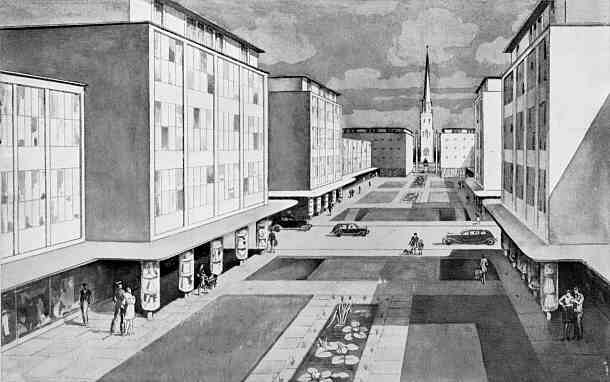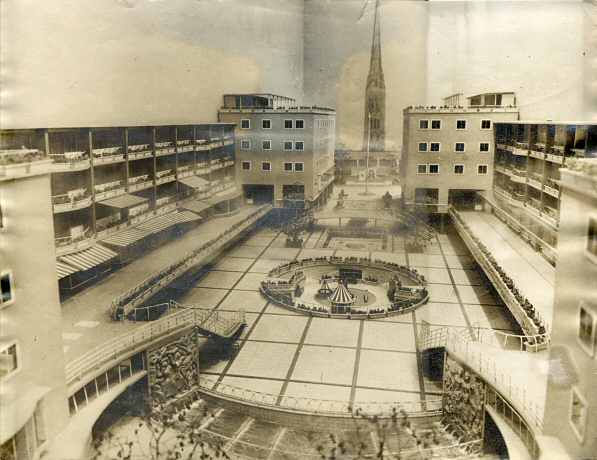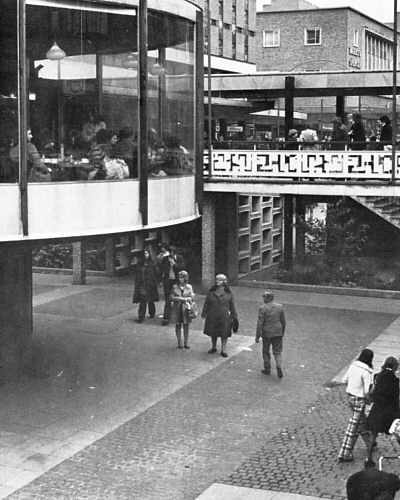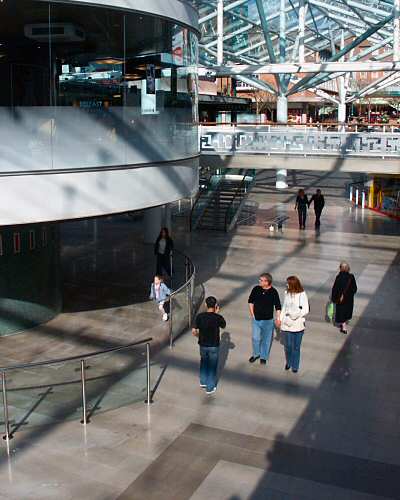|
Index...
|
 s this pleasant image testifies, the architects plans for a new pedestrian precinct were quite mature well before the Second World War came to a close. Of course, as we have come to expect in recent times; the finished article simply never reflects the artists impression that looks so inviting initially.
s this pleasant image testifies, the architects plans for a new pedestrian precinct were quite mature well before the Second World War came to a close. Of course, as we have come to expect in recent times; the finished article simply never reflects the artists impression that looks so inviting initially.

From the above sketch though, it's apparent that the plan to have a two-tier shopping system had not yet been developed.
By 1948, however, it seems that the idea of an upper level had been embraced, and the original photo of a model showing this later design is below. It is also apparent from both ideas that the vista of the Old Cathedral spire was of prime importance to the layout of the precinct. (Present day architects - please take note !)
Although many aspects of the model do appear in the eventual product, I can only assume that the usual lack of funding was responsible for the exclusion of some of the extra features, like the sunken mini fairground in the centre, and the curving garden in the foreground.

The eventual two level layout has always caused problems with retailers in Coventry; understandably people are reluctant to go out of their way to climb stairs or slopes to reach shops when the ones at ground level satisfy their demand. Consequently, many retail units on the upper balcony, particularly around the upper precinct, have remained empty for much of the precinct's life.


Also conspicuous by its absence in this drawing is the slope that has shaped our precinct's design throughout. Because of this slope, the lower precinct's raised area is actually level with the floor of the upper precinct and therefore suffers less from people's avoidance of climbing.
For all its shortcomings though, the radical design was the first of it's kind and considered most desirable by architects worldwide. The new minimalist pedestrianised precinct in the style labelled the "Festival of Britain" was copied throughout Europe.
Those Coventrians who had seen the complete destruction of "Old Coventry", however, were to require a little more convincing.... their city had become unrecognisable almost overnight - not just the new buildings, but most of the town centre's streets had disappeared. Many memories lay in those places and now nobody could even point with any certainty to where they had once walked, shopped, danced or dated!
As time passed, it became apparent that the exhibition mentioned above had little effect in procuring the interest of the average person in Coventry. Most were much too involved in rebuilding their family lives, careers and businesses after the disruption of the war and were quite indifferent to the enthusiasm of the council for planning the new city.
However, despite the lack of public enthusiasm for the reconstruction programme, youngsters who were then being 'brought up' with the new Coventry, slowly developed a sub-concious pride in their town and in the 21st century can look back with fondness at certain aspects, like the "mushroom cafe" pictured here, and the then new Broadgate Garden (see the next page) with Lady Godiva proudly displayed in the centre. If you'd like to see more of these "before and after" photos, try the "Now and Then" section.
Fortunately, by the 1950s Coventry was also entering a particularly prosperous period fuelled by the success of the car industry and this must have helped enormously in inflating the spirits of those who had previously struggled just to make ends meet. Other things came along too, the building of the New Cathedral of St. Michael perhaps being the single most symbolic happening for Coventry and gained us world-wide attention once again - this time for a more positive reason!
The Phoenix was indeed rising from the ashes.
This is your first visit to my website today, thank you!
3,155,954Website by Rob Orland © 2002 to 2024